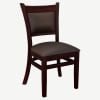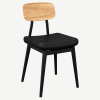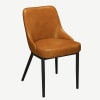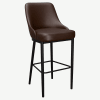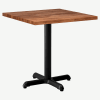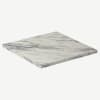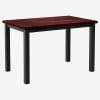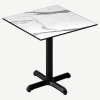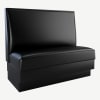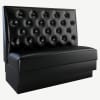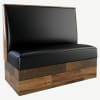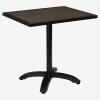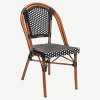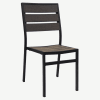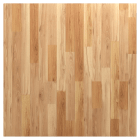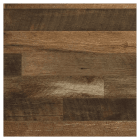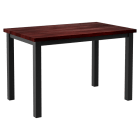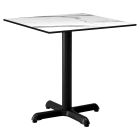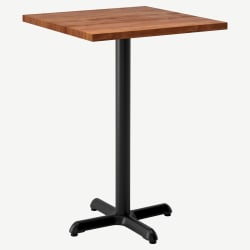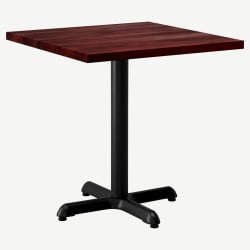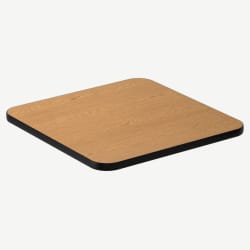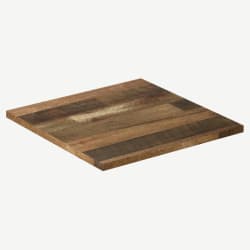Restaurant Tables
Let Your Customers Dine In Style On Our Exquisite Restaurant Dining Tables
Popular Products
At Seating Masters, we take great pride in offering a diverse selection of restaurant tables that are suitable for any establishment. Our tables are available in a wide range of sizes, shapes, materials, and finishes to ensure a perfect fit for your space. Whether you're furnishing a trendy café, a bustling restaurant, or a sophisticated hotel, we can meet your specific needs and style preferences.
Commercial Tables Materials and Usage
- Solid wood tables are commonly used in high-end restaurants and bars, as they are durable and easy to maintain. However, they require regular maintenance to maintain their appearance.
- Veneer table tops offer the appearance and aesthetic of real wood while being more cost-effective and versatile.
- For high-traffic environments, laminate tables are a great choice as they are scratch-resistant and easy to maintain. We offer a plethora of laminate options from trusted brands like Wilsonart and Formica.
- Resin table tops are ideal for fast food and family-style restaurants as they are crafted with a mixture of resin and hardener for utmost durability.
- Stainless steel tables are popular in ice cream shops and patios due to their resistance to rust and corrosion. These tables are constructed with outdoor use in mind.
- Synthetic teak and Werzalit tops are made of high-density polyethylene and weather-resistant bonded wood, making them perfect for outdoor use with their UV and water-resistant properties.
Tips on Choosing Your Restaurant Tables
When selecting the right commercial table top, there are several tips to consider. First, evaluate the material of the table top. Each material has its own strengths and weaknesses, so think about factors like durability, maintenance requirements, and aesthetic appeal. Consider how much wear and tear it will experience, the level of maintenance needed, and the resistance required against stains, heat, and spills. For instance, if you own a busy family restaurant, it may be wise to choose a table top that is scratch-resistant, heat-resistant, and stain-resistant.
The table top should match the overall theme and atmosphere of your commercial space. Pay attention to the style, color, and texture to ensure it complements your decor and enhances the overall appearance of your business. Consider as well the ease of cleaning and maintenance for the table top. Some materials, like laminate and stainless steel, are easy to clean and require minimal upkeep. Conversely, wood may need special care and periodic sealing to maintain its beauty and longevity. Remember, investing in a high-quality and durable table top now can save you money in the long run by avoiding frequent replacements.
The seating capacity of a table is an important consideration for any commercial restaurant space. The size and shape of the table top will directly impact the number of people it can accommodate comfortably. Round tables typically seat fewer individuals compared to rectangular or square tables of the same size. However, round tables offer a more intimate setting.
On the other hand, square and rectangular tables are well-suited for large gatherings as they can easily seat a large number of people. When determining the appropriate size and shape for optimal seating capacity, it is crucial to consider the available space and the desired layout.
Frequently Asked Questions
How do I Choose the Right Table Top Material for my Restaurant?
Pick a surface that fits your look, stands up to daily use, and stays on budget. Consider your concept, traffic, cleaning routine, and whether it’s for indoor or outdoor use.
- Style fit: Modern - quartz/metal; cozy/rustic - wood; fast-casual - laminate/resin.
- Durability & care:
- Wood: warm, premium feel; needs upkeep and protection.
- Laminate/Resin: affordable, easy to clean; less of a “luxurious" look.
- Stone/Quartz/Sintered: very durable and heat-resistant; heavier and higher cost.
- Maintenance: Check sealing needs, heat/chemical resistance, and ease of repair.
- Budget & lifespan: Avoid overspending on looks alone, or buying too cheap and replacing soon. Aim for a top that works hard, looks great, and lasts.
How Durable are Laminate Table Tops Compared to Solid Wood Tops?
Laminate is built for busy restaurants, resists scratches, heat, and moisture; wipes clean; no sealing required. Downsides: can’t be sanded or refinished if damaged, and deep chips may show.
Solid wood offers a warm, premium look and can be refinished, but needs sealing and more care. Is susceptible to scratches, stains, and heat/water marks. Bottom line: Pick laminate for low-maintenance durability; pick wood if you want the natural look and don’t mind upkeep.
What is a Drop Leaf Table?
A drop leaf table is a versatile restaurant table featuring one or two hinged leaves supported by articulated legs or brackets. This design includes a fixed section in the center and leaf sections on either side. The hinges can be easily adjusted, allowing for the expansion of the table surface. By popping the hinges up square tables can be effortlessly transformed into round ones.
What Size Table Tops do I Need?
The table size you need will vary depending on the number of diners you want to seat. Below are a few examples for the various sizes:
- 2 Person: 24" round; 24" x 24" square; 24" x 30" rectangular.
- 4 Persons: minimum sizes range from 30" x 30" square to 36" round and 24" x 48" rectangle.
- 6-8 Person: minimum sizes range from 42" x 42" square to 48" round and 30" x 60" rectangle.
- For parties with 8 or more diners (although relatively uncommon), we recommend having a drop leaf table or the flexibility to combine several tables as needed.
How Much Space do I Need Between Tables?
For comfortable flow, leave 24–30 in between table edges so guests can sit and move easily. Keep server walkways at a minimum of 36 in, and main aisles at a minimum of 48 in during peak service. Against walls, allow at least 24 in from table edge to wall. Modular layouts and drop leaf tables help you reconfigure for larger parties without clogging pathways. Tip: Always confirm local code/ADA requirements for clear widths and turning areas.
To gain further insight and guidance on determining the appropriate spacing for your restaurant, we recommend consulting our comprehensive restaurant design guide, which provides valuable information on optimizing layout and design for the best customer experience.


